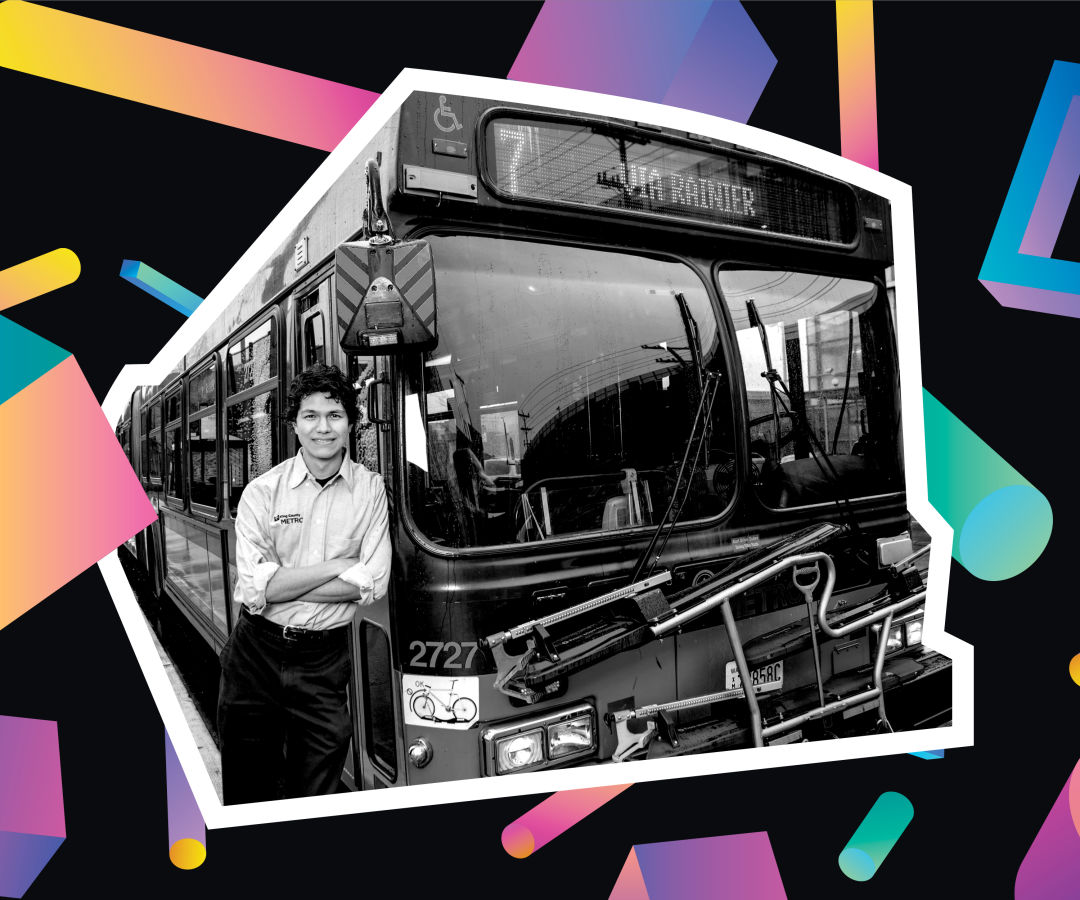
In the early days of the coronavirus pandemic, with offices and streets empty, driving the bus was easy for Nathan Vass. “It felt like it was 10:30 at night all day long,” he recalls.
The King County Metro senior operator knows that hour well. During his 13 years of driving, Vass has often worked the final shift of the day—the “late swing"—navigating through the University District, Downtown, Rainier Valley, and other neighborhoods on routes 7 and 49. Before Covid-19, the journeys across the city began with rush hour and ended, sometimes, with casual conversation among Vass and the few remaining passengers. “You can kind of wind down before you even finish,” he says.
But steering 60-foot vehicles through a public health crisis in 2020—buses that often carried essential workers and vulnerable non-destination passengers—hasn’t been one protracted exhale for Vass. The driver respects King County Metro’s health measures, such as an 18-passenger cap and a mask requirement, and believes the agency should be "commended" for implementing them. Yet the rules have brought stresses that add to the usual burdens of driving a bus—tough moments every driver is familiar with, like waking up passengers who’ve slept through entire route cycles. “There are situations that we’re in now that are not things we’ve had to think about before,” says Vass.
Take masks, for instance. Just as they have in political debates this year, face coverings have created conflicts aboard buses. “We’re not supposed to disallow riders to ride who are not wearing masks, but sometimes the passengers feel differently,” says Vass, noting that they might encourage him to pass up people who aren't wearing masks. King County Metro caps ridership on 60-footers at 18 people, but if the bus is below that amount upon reaching a stop, it must allow everyone in line there to board.
The rider limit has prompted some rumination behind the wheel. During this year’s Black Lives Matter demonstrations, protesters filled up buses en route to marches and other gatherings, which had an unintended consequence. “Then you’re having to pass up passengers of color who are trying to get to work,” says Vass, before adding, “Everyone’s cause in that situation is valid.” Perfect solutions to these philosophical dilemmas have proved elusive. “You just hope that you'll be able [to] react on instinct and come up with something that will displease the least amount of people, and try to articulate it in a way that conveys concretely that you mean well.”
Which is important to Vass. Pre-Covid, he was the cheerful driver primed to make it personal by saying “hi” to each person that got on his bus and calling out the stops himself. “I was very proactive about building a sense of community.... One of my favorite things about bus driving is people getting on through the front door, and me getting to acknowledge them and respect them.”
The outbreak jeopardized this connection. Back-door boarding and a fare moratorium (that has since been lifted) meant Vass could only welcome riders via announcements “that were probably totally useless,” he says, such as declaring the route name and destination. “Everybody on the bus already knows that. But in telling them, it's kind of like the sense of comfort you feel when you're on an airplane and the [pilot] is like, 'The flight’s going to take this amount of time, here's the weather.’”
In March, Vass worried about asymptomatically spreading the virus to susceptible homeless passengers that didn’t have access to hand washing or protection such as masks. Near the end of the month, he stopped driving and began 29 days of unpaid leave. King County Metro’s policies changed soon after, and Vass could take another month of leave, then paid, through the Emergency Paid Sick Leave Act. During his break from driving, Vass focused on writing. His debut book, The Lines That Make Us, draws from the vignettes he posts on his blog about navigating through the city and interacting with its residents.
Vass missed this way of “participating in society,” stepping back into the driver’s seat in June. Though King County Metro has instituted more safety measures since his return—partitions separate drivers from the rest of the bus, and mask dispensers on busy routes have helped boost mask use—he can’t believe he hasn’t contracted Covid-19 yet. He keeps the heat on to filter out the virus, he says, but it’s loud, making the conversations that he loves even more cumbersome. “The saving grace is that all this is temporary," he says, "and eventually we're going to go back to a situation where people are talking to each other and feel more prone to ask questions. I don't think that's going to go away. People like connecting. But for now, it's a little different.”
"follow" - Google News
December 22, 2020 at 12:07AM
https://ift.tt/3nFlxxF
Bus Drivers Had to Follow Some Wrenching Directions in 2020 - seattlemet.com
"follow" - Google News
https://ift.tt/35pbZ1k
https://ift.tt/35rGyU8
Bagikan Berita Ini














0 Response to "Bus Drivers Had to Follow Some Wrenching Directions in 2020 - seattlemet.com"
Post a Comment